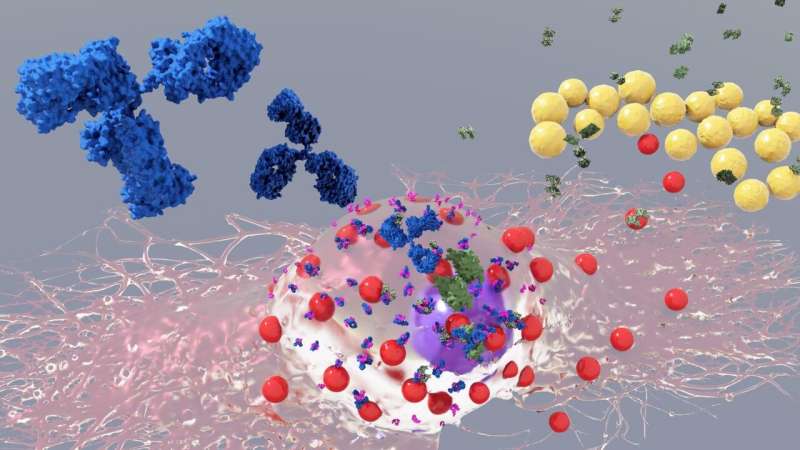Allergic immune responses help fight bacterial infections

Allergy is one of the most common diseases in Europe, it is estimated that more than 150 million Europeans suffer from recurring allergies and by 2025 this could have increased to half of the entire European population.1 Allergic patients initially undergo a process of 'sensitization,' meaning that their immune system develops a specific class of antibodies, so called Immunoglobulin E antibodies (IgE), which can recognize external proteins, referred to as allergens. IgEs bind and interact with cells that express a specific receptor called FcεR1. There are only a few cell types in the body that express the FcεR1 receptor and probably the most important ones are mast cells, a type of immune cell found in most tissues throughout the body.
When re-exposed to the allergen, mast cells (with IgE bound to their FcεR1 receptors) immediately react by rapidly releasing different mediators (e.g. histamine, proteases or cytokines) that cause the classic allergic symptoms. These symptoms depend on the tissue where the contact with the allergen happens and can range from sneezing/wheezing (respiratory tract) to diarrhea and abdominal pain (gastrointestinal tract) or itching (skin). Systemic exposure to allergens can activate a large number of mast cells from different organs at the same time, causing anaphylaxis, a serious and life-threatening allergic reaction.
Despite decades of research and detailed knowledge of the critical role of IgEs and mast cells in allergies, the physiological, beneficial function of this "allergy module" is still not completely understood. In 2006, Stephen J. Galli, senior co-author of this study, and his laboratory at Stanford University revealed the importance of mast cells for innate resistance against venoms of certain snakes and the honeybee. Subsequent work from the Galli laboratory showed the critical role of the 'allergy module' in acquired host defense against high doses of venom: this finding (to which Philipp Starkl, first author of the current study, contributed importantly) represented the first clear experimental evidence supporting the 'Toxin Hypothesis' postulated by Margie Profet in 1991. This hypothesis proposed a beneficial function for allergic reactions against noxious substances.
Following up on this discovery, Philipp Starkl, Senior Postdoctoral fellow at the Medical University of Vienna and CeMM, together with Sylvia Knapp, Professor at the Medical University of Vienna and CeMM PI, and Stephen J. Galli, Professor at Stanford University School of Medicine, and colleagues, set out to investigate whether this phenomenon could be relevant in defense against other toxin-producing organisms, in particular, pathogenic bacteria. The authors selected the bacterium Staphylococcus aureus as pathogen model due to its enormous clinical relevance and broad repertoire of toxins. This bacterium is a prototypic antibiotics-resistant pathogen and is also associated with the development of allergic immune responses in diseases such as asthma and atopic dermatitis. For their research, they used different experimental S. aureus infection models in combination with genetic approaches and in vitro mast cell models to reveal the functions of selected components of IgE effector mechanisms.
The scientists found that mice with a mild S. aureus skin infection develop an adaptive immune response and specific IgEs antibodies against bacterial components. This immune response grants these mice an increased resistance when they are confronted with a severe secondary lung or skin and soft tissue infection. However, mice that are lacking functional IgE effector mechanisms or mast cells are unable to build such protection. These findings indicate that the "allergic" immune response against bacteria is not pathological, but instead protective. Hence, defense against toxin-producing pathogenic bacteria might be an important biological function of the allergy module.
This study is an important collaboration initiated by Philipp Starkl at the laboratory of Stephen J. Galli at Stanford University together with other colleagues and then continued at the laboratory of Sylvia Knapp at CeMM and the Medical University of Vienna. This exciting discovery not only advances the general understanding of the immune system and most notably allergic immune responses, but it could also explain why the body has maintained the allergy module throughout evolution. Despite their dangerous contributions to allergic diseases, IgEs and mast cells can exert beneficial functions that the immune system can capitalize on to protect the body against venoms and infections with toxin-producing bacteria, such as S. aureus.
More information: Philipp Starkl et al, IgE Effector Mechanisms, in Concert with Mast Cells, Contribute to Acquired Host Defense against Staphylococcus aureus, Immunity (2020). DOI: 10.1016/j.immuni.2020.08.002



















